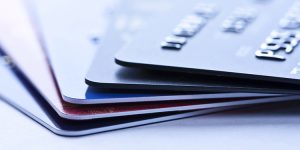A guide to getting rid of your credit card debt
Table of contents
Credit card debt can quickly mount up and if you are finding it tough to repay what you owe, there are ways to tackle your credit card debt and free yourself from increasing interest costs.
In some cases, if the debt on a credit card is high, this means the minimum monthly payment may not even cover the interest charged that month. So, the debt continues to increase, even though the payments are being made.
We’ve broken down how to reduce and get rid of credit card debt in five easy steps:
Step 1: Add up what you owe on your credit cards
If you have more than one credit card, you may have lost track of what you owe and to which company. Take some time to look through your statements and work out exactly how much credit card debt you owe.
Step 2: Reduce your expenses
Budgeting is important when it comes to tackling your debts. Take time to look at your income and expenses and work out what can be removed to free up some cash to put towards your credit card debts.
Cancel that gym membership you don’t use, haggle for a better deal on your car insurance when it comes up for renewal, end a magazine subscription – simply look for ways to cut back on what you are spending. Our guide on how to avoid debt breaks down how to set up a budget and get spending back on track – click here to read more.
Step 3: Move your debt to a 0% interest card
Stop paying interest altogether and consolidate your credit card debt to one 0% interest credit card with a long welcome period. A comparison site may be able to offer a range of deals to choose from that suit you.
This means your credit cards will be paid off and the debt will no longer continue to rise as there is no interest to worry about right away – if payments are managed and made on time within the 0% interest period. Monthly payments will be easier to manage too, as they will all go out as one expense if you have consolidated your debts onto one credit card.
Bear in mind there may be a balance transfer fee to pay when moving credit card debt to another card. The bigger the debt, the bigger this charge is, so check before you agree to anything.
If your credit rating is low and so you are struggling to get a 0% interest deal it is still a good idea to shop around and consolidate your debt onto a lower interest rate card. This guide can help you find a way to improve your credit rating to get the best deal.
Step 4: Cut up your credit cards
You want to remove this debt, so it’s important you are not tempted to use the credit cards and add to the amount owed.
Many people see them at first as a safety net but this can quickly change as they find it easy to spend money they don’t have on them.
This, of course, can lead to a cycle of debt that you may be unable to break. If you owe a bigger amount you are unable to repay before it rolls over into the next month. If you are not able to pay your credit card off in full every month, then the amount you owe – and interest on this debt – will soon increase. With this in mind, make sure you don’t spend on your credit card if you don’t really need to – or unless you’re confident you’re able to pay this money back.
Step 5: Put a plan in place to repay what you owe
We recommend, if possible, paying more than the minimum amount on your credit cards to speed up the process – that budget you’ve put in place can then help with this, as any spare cash can be put towards clearing the debt.
If this isn’t possible, at the very least ensure you make the minimum repayment every month.

Things to think about when removing credit card debt:
- Have you got the best deal? – Companies send out tempting offers all the time on credit cards, but don’t go for the first one you see. Some credit cards offer incentives so shop around on comparison sites first before settling.
- Is there a balance transfer fee? It’s important you check if there are any fees to pay for transferring your credit cards to a new one – if you have decided to consolidate your debt onto a new lower interest rate card. The fee is a percentage of the full amount so if this is particularly high, it may not be worth it.
- Always repay the minimum amount. If you find that funds are particularly tight one month and you can’t make that bigger payment that’s fine, simply ensure you at least make the minimum expected repayment to keep the account in good order.
Alternative ways to remove credit card debt
In some cases, if your credit rating is poor, you may find it hard to get a 0% interest credit card and so another solution is required.
Snowballing
For people with more than one credit card debt to deal with, snowballing means focusing on the largest debt and removing this first. So, in the case of a credit card, this would be the debt with the highest interest rate (APR).
Here’s a quick example:
- You owe £2,000 on credit card A (19% APR) and pay £60 a month
- You owe £5,500 on credit card B (15% APR) and pay £100 a month
- You owe £800 on credit card C (8% APR) and pay £30 a month
Even though you owe less on credit card A, the interest is higher and so this needs to be tackled first. To do this, you need to increase the monthly repayment on credit card A and only pay the minimum amount on credit cards B and C. Bear in mind that interest will still be added to the debts on B and C, but this tactic will remove the debt on credit card A quicker, while still ensuring you make repayments on the other two.
Once this debt is removed, you can then move onto the next card with the highest interest rate – credit card B in this case – until all the debt has been paid.
We recommend you stop spending anymore on these credit cards, to avoid the amount owed from going up anymore. This won’t affect the interest that is being added but it does mean you can avoid adding more debt yourself to what you need to pay. 
Find a debt solution that works for you
If you are struggling to make the minimum repayments on your credit card debt, a debt solution may be the best option. There are a few of these to choose from:
Debt Management Plan (DMP)
This debt solution consolidates your debts into one manageable monthly repayment. However, it is an informal solution so interest and charges can still be added to your credit card debt. We have more information about DMPs here.
Individual Voluntary Arrangement (IVA)
This is an insolvency solution – so it should not be taken lightly – and may be best for those who owe at least £7,000 and are struggling to meet the minimum repayments. It will take five years to process and you may be asked to remortgage your home. An IVA can wipe up to 80%* of your debts and allow you to make a manageable monthly repayment that is shared amongst all of your creditors. You can find out more about what an IVA is by reading our guide.
Bankruptcy
A final, last resort solution – bankruptcy uses the sale of your assets, such as your home, to repay large amounts of your debt – and then removes these. It is a serious solution and should only be considered if you have exhausted all other options.
We have lots of guides here on our site as well as detailed articles around credit cards and bankruptcy. You can find out more about bankruptcy as a whole by clicking here.
Feeling ready to tackle your credit card debt? Speak to a member of our team here at PayPlan if you need any further advice or help. Simply call on 0808 278 3459 or use our contact form to get in touch.
*In 2018, PayPlan Partnership Ltd and PayPlan Bespoke Solutions Ltd wrote-off up to 80% of debt in half of all non-equity cases.
Comments 2
I can’t get consolidation can not get payment plan to write off some off the debt iv been struggling pay minimum on both cards over two years now never making any dent on what I owe any suggestions how get bank stop interest ?
Do you live in the United Kingdom as we only offer advice here. You will never get them to stop adding interest if you can make the full contractual payments. If you wish them to do this you would need to reduce the payments you are making and offer only what you can afford and explain why. It is then up to them if they will freeze interest and charges – and of course not use any further credit from anywhere whilst you are doing this.
If you telephone Payplan on 0808 278 6944 one of our trained advisers will be able to offer full advice. I have emailed our repayment arrangement guide to the email address you have supplied.
Comments are closed.
